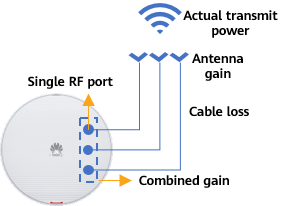What Is Combined RF Power?
The combined RF power refers to the combined transmit power of multiple radios on an AP. It is the input power of AP antennas. The actual transmit power of an AP is equal to the combined RF power plus the antenna gain and minus the cable loss. The combined RF power directly affects the signal transmit strength of an AP, and thereby can be used to evaluate the signal transmit capability of the AP.
How Do I Calculate the Combined RF Power?
Earlier APs had only one radio and therefore does not involve the concept of combined RF power. As Wi-Fi technologies develop, 802.11n is the first standard that supports multiple-input multiple-output (MIMO). With this technology, an AP can use multiple radios to transmit and receive radio signals simultaneously, and each radio has its own transmit power. The combined RF power is the combined transmit power of all RF ports on a frequency band. For an AP that supports both 2.4 GHz and 5 GHz radios, each radio has its own combined RF power. The combined RF power is the sum of the power of a single RF port (single chain) and the combined gain.
- RF port power: indicates the power at which the AP transmits signals to the RF port connected to an antenna. The maximum and minimum specifications vary depending on hardware capabilities.
- Combined gain: indicates the gain brought by the transmission of multiple radios. The combined gain is 10lg(number of RF ports) dBm. Therefore, the typical combined gains of radios are 3 dBm for two radios, 5 dBm for three radios, and 6 dBm for four radios.
The combined RF power is calculated as follows:
Combined RF power = Power of a single RF port + Combined gain
An AP supports 3x3 MIMO on its 2.4 GHz radio. That is, the AP supports three RF ports. Assuming that the transmit power of a single RF port is 20 dBm and the combined gain of the three RF ports is 5 dB, the combined RF power is 20 + 5 = 25 dBm.
Note that in the preceding calculation process, the combined RF power is not the simple sum of the transmit power of all RF ports. Instead, the combined gain is added.

Combined RF power
What Is the Relationship Among the Combined RF Power, Actual Transmit Power, and Antenna Gain?
Typically, an AP transmits data signals in the following steps:
- Emits signals from RF ports of the AP.
- Carries signals through feeders and conversion adapters.
- Sends out signals by the antennas.
Based on this signal transmission process, it can be inferred that the final transmit power of a radio also involves the cable loss and antenna gain, in addition to the transmit power of an RF port and the combined gain of multiple RF ports mentioned above. Therefore, the actual transmit power is represented using the Effective Isotropic Radiated Power (EIRP), which is calculated using the formula:
EIRP = Combined RF power – Cable loss + Antenna gain
For example, if the combined RF power, cable loss, and antenna gain are 25 dBm, 1 dB, and 3 dBi respectively, the EIRP is 27 dBm (25 – 1 + 3). The relationship among the combined RF power, actual transmit power, and antenna gain is shown below.

Actual transmit power
Can More Antennas Necessarily Deliver Higher Power and Stronger Signals?
The answer is yes. According to the formula for calculating the combined gain, that is, 10lg(number of RF ports) dBm, the number of RF ports is in direct proportion to the combined gain. On an AP, the number of RF ports is the same as the number of antennas. Therefore, more antennas bring a higher combined gain. The formula for calculating the actual transmit power is as follows:
EIRP = Combined RF power (RF port power + Combined gain) – Cable loss + Antenna gain
According to this formula, a higher combined gain indicates higher actual transmit power and stronger Wi-Fi signals.
- Author: Si Xianchao
- Updated on: 2023-08-09
- Views: 2634
- Average rating:







